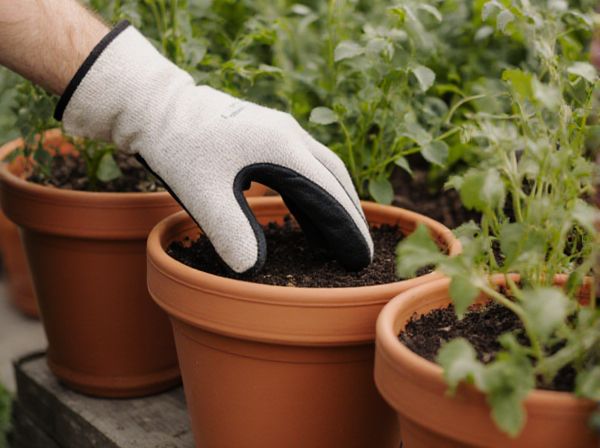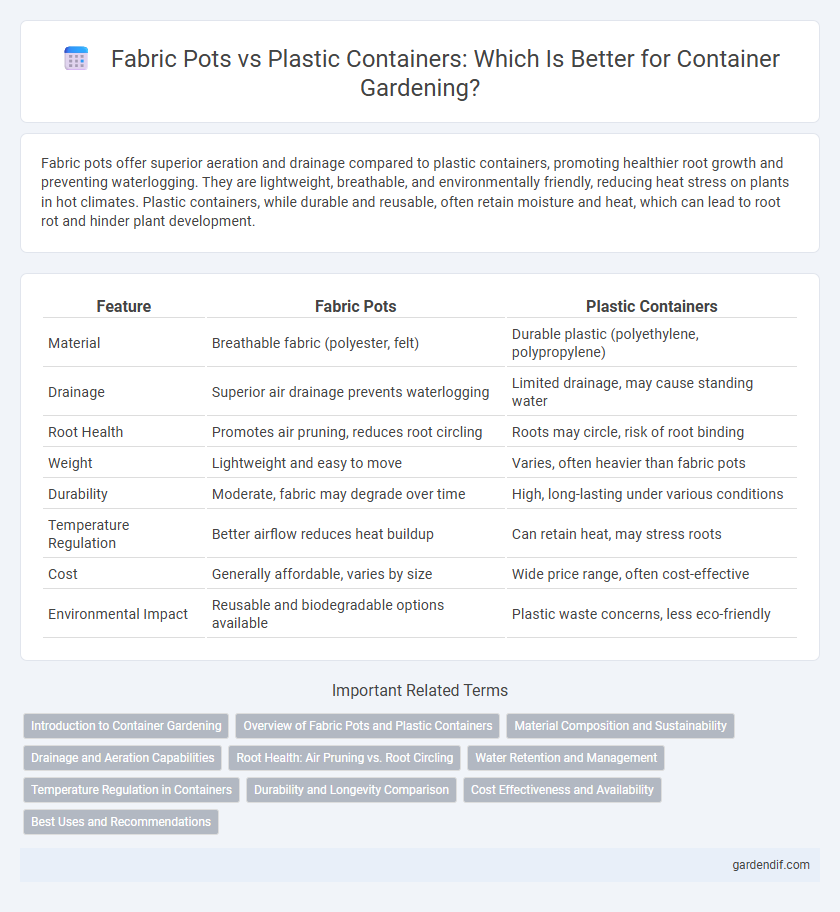
Fabric pots vs plastic containers Illustration
Fabric pots offer superior aeration and drainage compared to plastic containers, promoting healthier root growth and preventing waterlogging. They are lightweight, breathable, and environmentally friendly, reducing heat stress on plants in hot climates. Plastic containers, while durable and reusable, often retain moisture and heat, which can lead to root rot and hinder plant development.
Table of Comparison
| Feature | Fabric Pots | Plastic Containers |
|---|---|---|
| Material | Breathable fabric (polyester, felt) | Durable plastic (polyethylene, polypropylene) |
| Drainage | Superior air drainage prevents waterlogging | Limited drainage, may cause standing water |
| Root Health | Promotes air pruning, reduces root circling | Roots may circle, risk of root binding |
| Weight | Lightweight and easy to move | Varies, often heavier than fabric pots |
| Durability | Moderate, fabric may degrade over time | High, long-lasting under various conditions |
| Temperature Regulation | Better airflow reduces heat buildup | Can retain heat, may stress roots |
| Cost | Generally affordable, varies by size | Wide price range, often cost-effective |
| Environmental Impact | Reusable and biodegradable options available | Plastic waste concerns, less eco-friendly |
Introduction to Container Gardening
Fabric pots offer superior aeration and drainage compared to plastic containers, promoting healthier root development in container gardening. Their breathable material prevents root circling and reduces the risk of overwatering by allowing excess moisture to evaporate efficiently. Plastic containers retain moisture longer and are typically more durable but may cause root-bound plants due to limited airflow.
Overview of Fabric Pots and Plastic Containers
Fabric pots offer superior aeration and drainage compared to plastic containers, promoting healthier root growth and preventing waterlogging. Plastic containers are durable, lightweight, and often more cost-effective, making them suitable for long-term use and varied growing conditions. Both container types serve distinct horticultural needs, with fabric pots excelling in breathability and plastic containers providing structural stability.
Material Composition and Sustainability
Fabric pots, made from breathable non-woven polypropylene or recycled fibers, promote superior aeration and root health compared to traditional plastic containers, which are typically composed of petroleum-based polymers like polyethylene or polypropylene. In terms of sustainability, fabric pots offer enhanced environmental benefits through their reusable, biodegradable, or recyclable properties, whereas plastic containers often contribute to long-term landfill waste and have a larger carbon footprint due to fossil fuel dependency. Choosing fabric pots supports reduced soil compaction and improved water drainage, aligning with eco-friendly gardening practices and sustainable container use.
Drainage and Aeration Capabilities
Fabric pots excel in drainage and aeration capabilities due to their porous material, which allows excess water to escape and airflow to reach plant roots, preventing root rot and promoting healthy growth. Plastic containers often retain water longer and have limited airflow, increasing the risk of overwatering and reducing root oxygenation. Enhanced root zone oxygen levels in fabric pots lead to stronger root systems and improved nutrient uptake compared to plastic alternatives.
Root Health: Air Pruning vs. Root Circling
Fabric pots promote healthier root systems through air pruning, which naturally trims roots and prevents circling by exposing them to oxygen, enhancing nutrient uptake and growth. Plastic containers often cause root circling as roots hit the pot edges and begin to grow in circles, leading to poor root structure and reduced plant vigor. Choosing fabric pots improves overall root health, increases oxygen availability, and supports stronger, more resilient plants.
Water Retention and Management
Fabric pots offer superior water retention and aeration compared to plastic containers, allowing better root oxygenation and reduced risk of overwatering. Their breathable design facilitates efficient drainage, preventing waterlogging and promoting healthier root systems. Plastic containers tend to retain moisture longer but may cause root rot due to poor drainage and limited airflow.
Temperature Regulation in Containers
Fabric pots offer superior temperature regulation compared to plastic containers by allowing enhanced airflow through their breathable material, which dissipates heat effectively and prevents root overheating. Plastic containers tend to trap heat due to their impermeable surfaces, increasing the risk of thermal stress on plant roots during hot weather. This improved temperature control in fabric pots promotes healthier root systems and better overall plant growth.
Durability and Longevity Comparison
Fabric pots offer superior breathability and flexibility, reducing root circling and promoting healthier plant growth, but they generally have a shorter lifespan of 3 to 5 years due to material degradation from UV exposure and moisture. Plastic containers are more durable and can last over a decade, resisting weather elements and physical damage, though they may limit root oxygenation compared to fabric pots. Selecting between fabric and plastic containers depends on prioritizing plant health benefits or long-term durability needs.
Cost Effectiveness and Availability
Fabric pots often offer superior cost effectiveness due to their durability and reusability, reducing the need for frequent replacement compared to plastic containers. Plastic containers are generally more affordable upfront and widely available in various sizes and designs, making them accessible for immediate use. Availability of fabric pots is growing in garden centers and online as demand increases, but plastic containers still dominate mainstream markets.
Best Uses and Recommendations
Fabric pots provide superior aeration and drainage, making them ideal for growing vegetables and herbs with sensitive root systems. Plastic containers retain moisture longer, which suits drought-tolerant plants or indoor environments requiring less frequent watering. For gardeners seeking sustainable options, fabric pots are recommended due to their breathability and environmental benefits, while plastic containers offer durability and ease of movement for annuals and decorative plants.
Fabric pots vs plastic containers Infographic

 gardendif.com
gardendif.com